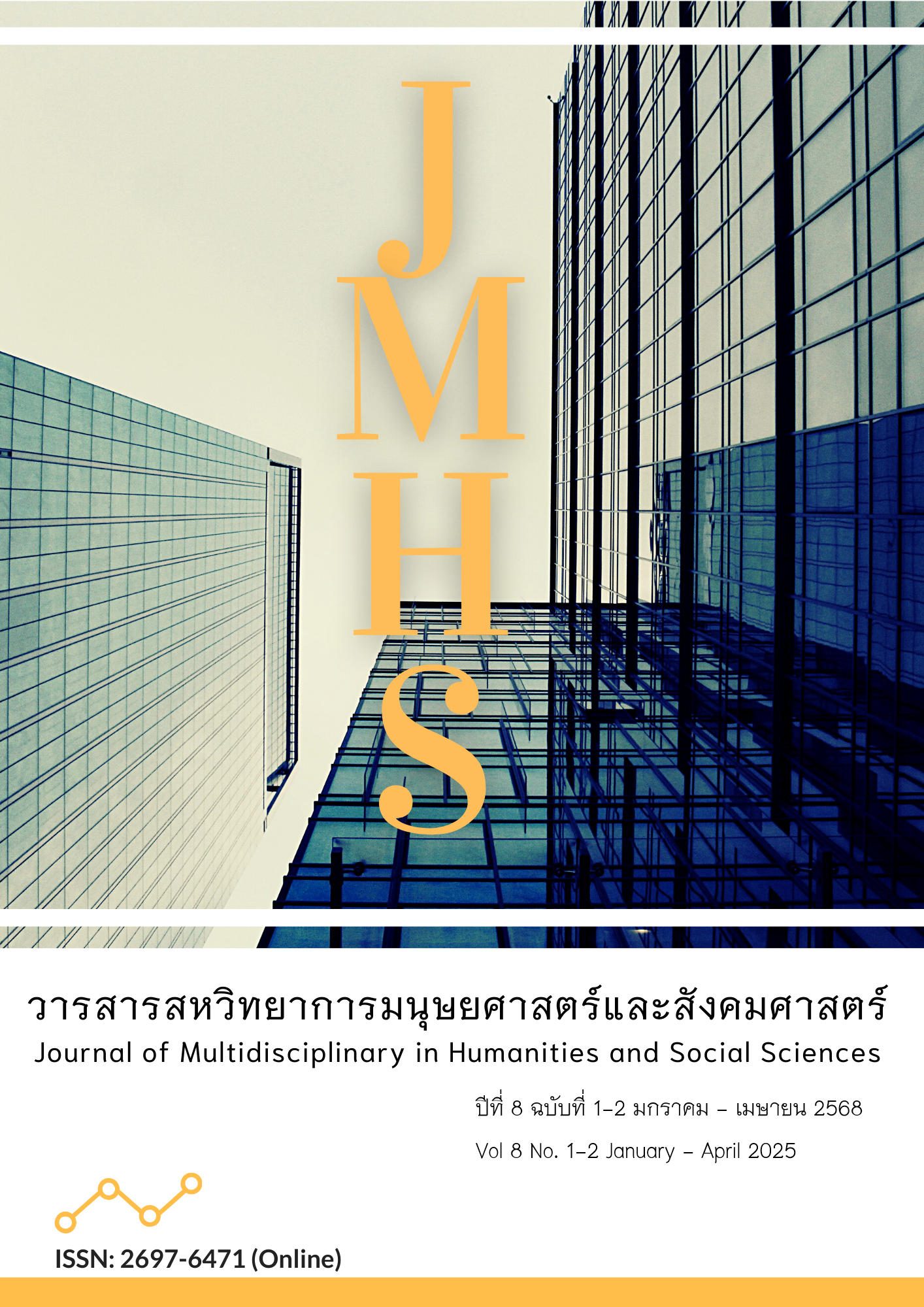Building Thailand-China Relations in a Third Country: A Case Study on the Promotion of Soft Power in the Lao People's Democratic Republic
Main Article Content
Abstract
Currently, Thailand's soft power in its international relations with the Lao People's Democratic Republic (Lao PDR) is facing significant challenges, particularly due to China's increasing influence. China has been extensively and intensively exporting its soft power across multiple dimensions, prompting Thailand to adjust its soft power strategy in Lao PDR to maintain its status and expand its role in the region. Therefore, it is crucial to study the resources and dynamics of Thailand’s and China’s soft power in Lao PDR, as well as the indirect impact of third-party countries on Thailand’s soft power in its international relations with Lao PDR. This understanding is essential for analyzing the dynamics of international relations and predicting future trends in soft power that may influence regional transformations.
This article forms part of a doctoral dissertation in the field of Politics and Development Strategy, titled “Thailand’s Use of Soft Power in International Relations with the Lao People's Democratic Republic.” The study employs a qualitative research approach, focusing on an in-depth analysis of Thailand’s use of soft power within the context of its international relations with Laos.
This section of the study reveals that the country most influential in driving Thailand's soft power in the Lao People's Democratic Republic (Lao PDR) is China, which plays a pivotal role. China's export of soft power into Laos encompasses all three sources of power as outlined in Joseph S. Nye’s theoretical framework: cultural, international policy, and political values. Furthermore, China holds a significant role in trilateral cooperation involving Thailand, China, and Laos. This cooperation can be categorized into four types: General city or provincial collaborations, Joint investments in general urban or provincial areas, National or regional-level collaborations, and Joint investments in special economic zones.
The primary objectives of this cooperation can be classified into four areas: Expanding intergovernmental cooperation to strengthen diplomatic relations, establishing trade and investment partnerships in Laos for the private sector, Attracting Chinese investors and citizens to develop greater interest in Thailand, and Promoting understanding and collaboration at the grassroots level among the three nations. This cooperation generates shared benefits in economic, social, and cultural dimensions, not only for Thailand and China but also for the Lao PDR as the host country. Additionally, this collaboration serves a wide array of goals beyond the economic scope, such as fostering cultural understanding, advancing social development, and building long-term amicable relationships. These outcomes are expected to be mutually advantageous for all three countries in the future.
Article Details

This work is licensed under a Creative Commons Attribution-NonCommercial-NoDerivatives 4.0 International License.
Views and opinions appearing in the Journal it is the responsibility of the author of the article, and does not constitute the view and responsibility of the editorial team.
References
กชภพ กรเพชรรัตน์. (2565). รัฐบาลไทยกับการผลักดัน Soft Power ท้องถิ่น เมื่อต้อง “สร้าง” อย่างเป็นระบบไม่ใช่เพราะ “โชคช่วย”. สืบค้นเมื่อ 7 กรกฎาคม 2566, จาก https://thestandard.co/thai-gov-and-local-soft-power/
กรมประชาสัมพันธ์. (2565). รัฐบาลเดินหน้าแผนเชื่อมระบบราง ไทย ลาว จีน เตรียมสร้างสะพานข้ามโขงแห่งใหม่ หนองคาย-เวียงจันทร์ จุดเริ่มต้นเชื่อมต่อรถไฟความเร็วสูง 5 ประเทศ. สืบค้นเมื่อ 14 สิงหาคม 2566, จาก https://thainews.prd.go.th/th/news/print_news/TCATG220813145720872
กรมประชาสัมพันธ์. (2566). สะพานมิตรภาพไทย - ลาว แห่งที่ 5 คืบกว่า 82.5% ประตูเชื่อมไทย-ลาว-เวียดนาม และมณฑลกว่างสีของจีน. สืบค้นเมื่อ 14 พฤศจิกายน 2566, จาก https://nbt2hd.prd.go.th/th/content/category/detail/id/2153/iid/198716
กรุงเทพธุรกิจ. (2566). “สพพ.” เพิ่มช่วยเหลือ สปป.ลาว ฝึกคนขับรถไฟ – ทำแผนธุรกิจสถานี ‘บ้านคำสะหวาด’. สืบค้นเมื่อ 2 ธันวาคม 2566, จาก
https://www.bangkokbiznews.com/business/economic/1082354
กองการต่างประเทศ สำนักงานปลัดกระทรวงมหาดไทย. (2563). คู่ความสัมพันธ์เมืองพี่เมืองน้องระหว่างไทยกับต่างประเทศ. สืบค้นเมื่อ 23 พฤศจิกายน 2566, จาก http://www.fad.moi.go.th/images/ngancedkumpha/karakada/list%E0%B8%A3%E0%B8%A7%E0%B8%A1_Sister_CITY.pdf
นันทรัตน์ วัฒนศรีมงคล. (2555). นโยบายการค้าระหว่างประเทศของสาธารณรัฐประชาธิปไตยประชาชนลาวต่อสาธารณรัฐประชาชนจีน ระหว่างปี พ.ศ. 2549-2553(ภาคนิพนธ์หลักสูตรศิลปศาสตรบัณฑิต สาขาเอเชียตะวันออกเฉียงใต้ศึกษา). มหาวิทยาลัยธรรมศาสตร์.
พรภวิษย์ หล้าพีระกุล และ ปารมิตา แซ่เตียว. (2564). การเปลี่ยนผ่านนโยบาย “อำนาจอ่อน” สู่ “อำนาจแหลมคม” ของจีนในศตวรรษที่ 21. วารสาร MFU Connexion: Journal of Humanities and Social Sciences, 10(2), 79-92. DOI: 10.14456/connexion.2021.17
ศูนย์ข้อมูลเพื่อธุรกิจไทยลาว. (2562). ความสัมพันธ์กับไทย. สืบค้นเมื่อ 23 พฤศจิกายน 2566, จาก https://thaibizlaos.com/lao/about/relations.php
สถานเอกอัครราชทูต ณ เวียงจันทน์. (2565). ยุทธศาสตร์การดึงดูดการลงทุนของลาว กับการพัฒนาเขตเศรษฐกิจพิเศษอย่างต่อเนื่อง. สืบค้นเมื่อ 23 พฤศจิกายน 2566, จาก https://vientiane.thaiembassy.org/th/content/%E0%B
สถานเอกอัคราชทูต ณ กรุงปักกิ่ง. (2565). ความสัมพันธ์ไทย-จีน. สืบค้นเมื่อ 2 ธันวาคม 2566, จาก https://thaiembbeij.org/th/republic-of-china/thai-relations-china/
สำนักข่าวกรองแห่งชาติ. (2566). ลาว-จีน เห็นพ้องที่จะส่งเสริมความร่วมมือทางเศรษฐกิจและอุดมการณ์ทางการเมืองระหว่างกัน. สืบค้นเมื่อ 2 ธันวาคม 2566, จาก https://www.nia.go.th/news/page/4125/
สำนักงานการท่องเที่ยวจังหวัดเชียงราย. (2556). สะพานมิตรภาพ 4 (เชียงของ-ห้วยทราย). สืบค้นเมื่อ 7 ธันวาคม 2566, จาก https://www.cots.go.th/travelview/detail.php?id=223
Bank Group. (2020). From Landlocked to Land-Linked Unlocking the Potential of Lao-China Rail Connectivity. สืบค้นเมื่อ 23 พฤศจิกายน 2566, จาก https://documents1.worldbank.org /curated/en/648271591174002567/pdf/Main-Report.pdf
BBC New. (2566). จีนเที่ยวไทยจะกลับมาตามคาดหรือไม่ หลังรัฐบาลเศรษฐา เปิดวีซาฟรี. สืบค้นเมื่อ 3 ธันวาคม 2566 จาก https://www.bbc.com/thai/articles/c3g3dqd7ywwo
CRI Online. (2020). มหาวิทยาลัยแห่งชาติลาว จัดงาน “วันสถาบันขงจื่อ”. สืบค้นเมื่อ 2 ธันวาคม 2566, จาก https://thai.cri.cn/20201031/f73be219-691e-942c-dfdd-1ce2a0b544d0.html
Jnew. (2565). สปป. ลาวกำหนด 6 เป้าหมายในการพัฒนาเศรษฐกิจและสังคม ช่วงปี 2564 – 2568. สืบค้นเมื่อ 2 ธันวาคม 2566, จาก https://globthailand.com/laos-190421/
Nye, J. (2004). Soft Power: The Means to Success in World Politics. New York: Public Affairs.
SCB Bank. (2565ก). Laos Insights and Update 2021 “รู้ก่อนรุก สปป. ลาว แลนด์ลิงค์ เชื่อมการค้าโลก”. สืบค้นเมื่อ 4 ธันวาคม 2566, จาก https://www.scb.co.th/th/personal-banking/stories/business-maker/laos-landlink-global-trade.html
SCB Bank. (2565ข). ส่องโอกาสที่นักธุรกิจไทยจะได้รับจากรถไฟฟ้าจีน-ลาว. สืบค้นเมื่อ 7 กรกฎาคม 2566, จาก https://www.scb.co.th/th/personal-banking/stories/business-maker/thai-business-opportunity-in-laos.html
Vientiane Times. (2023). Laos-China Railway carrying record 10,000 passengers a day. สืบค้นเมื่อ 2 ธันวาคม 2566, จาก https://www.vientianetimes.org.la/freeContent/FreeConten46 _Laos_china_y23.php

